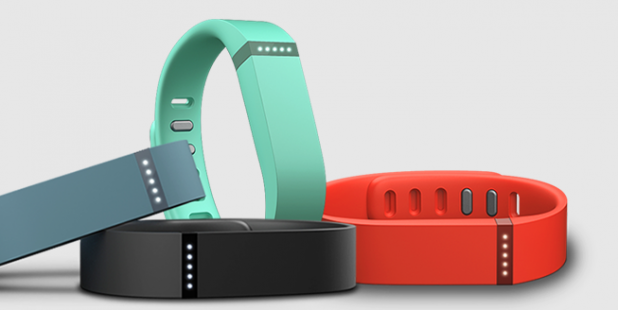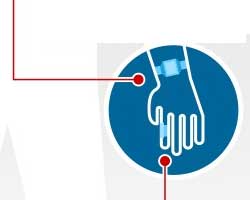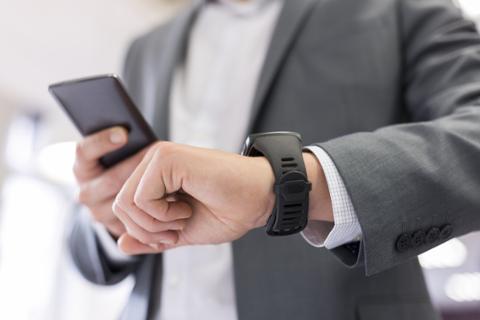[caption id="attachment_17501" align="aligncenter" width="618"]

FitBit and other "smart" bracelets could help determine whether people embrace wearable electronics.[/caption] Real-time data feeds from employee biometric information. Massive infrastructure loads from numerous heads-up displays (HUD). And a never-ending string of updates and administration to ensure the integrity of devices. Those are just a few of the IT issues raised by the introduction of wearable computers in the enterprise. But I won’t bore you with another buzz-term like Bring Your Own Wearables (BYOW). Gartner predicts that wearable computers will become a
$10 billion market, but it’s safe to say that prediction is somewhat liberal. Until hardware manufacturers can overcome the geekdom of wearables, mass consumer adoption will remain a pipe dream. Although Google has taken steps to make Glass more fashionable by partnering with
Warby Parker, business users are notoriously less picky when it comes to aesthetics: from pagers to Bluetooth headsets, a great deal of enterprise technology is not pleasing to the eyes. What is important is the function and usability of the device, as well as the software that brings it to life. Despite this next progression in computing having a better chance in the enterprise, there are still significant obstacles when it comes to building the apps that will provide true value.
Delivering Information with Limited Screen Size
One of the major challenges for developers creating software for wearables centers on how to best display information. At this point, we’ve seen devices such as smart watches that feature screens between 1.3 and 1.6 inches. The FitBit, arguably one of the most popular wearable devices available, has virtually no interface for “content.” Software designers will have to remain creative and user-centric when creating apps. Depending on the specific context, content will need to be delivered in a different manner. Google Glass apps created for a
Virgin Airlines stewardess to better assist passengers will be noticeably different than an app built for Lockheed Martin engineers to visually analyze a missile prototype. Context will be central to delivering content via wearable devices. In most instances, the wearable device will not garner direct interaction from the user. Handsfree is the ultimate goal for wearables. What will truly drive value, and avoid process disruption, are the backend systems used to administrate and interact with devices. Although the FitBit bracelet lacks an interface, the intuitively designed
back-end system is what provides real value to the user. FitBit could be a great device for tracking the pulses and locations of a large factory floor workforce; if an accident happens, an instant notification is sent to a manager as heart rates spike. Wearables must make it easy to seamlessly discover pertinent information as it is produced, rather than waste time searching.
The Need for Extension Apps
As it stands right now, the pioneer companies that implement wearable devices for workers will depend on companion apps. With such limited screen real estate, software engineers will have to build corresponding extension apps to interact with the overall system. While devices such as
Google Glass have a decent display size for building apps, many wearables do not. In fact, some of the most useful wearables use the device as a tag for catching data, while an extension app on a separate device is used for analysis. Indeed, wearers will likely never see much of the software needed to implement wearables in the enterprise. Syncing data from hundreds of wearables to a software application used by management is a significant challenge. Data integration and protocols will also be crucial as a means to ensure security. Software teams will need to focus on disseminating troves of data into visualizations and interactive dashboards. CNBC recently reported that:
"Cisco predicts mobile data traffic will top 190 exabytes worldwide by 2018. That would be an 11-fold increase from 2013's traffic… and one of the major factors is the wearable device trend."
With such a vast influx of information, IT and software development teams will have their work cut out for them. In the same way that enterprises faced the challenge of Bring Your Own Device (
BYOD) policies and Mobile Device Management (
MDM) systems, wearable devices will bring about another substantial shift in enterprise technology.
Challenging But Exciting
There has never been a better time to develop software. In a
Wall Street Journal report,
software engineers were ranked as the third best job in the United States for 2013. With so much potential and technological progression in this field, innovative hardware such as Google Glass and FitBit have a greater chance of surviving. As developer skills adapt to the needs of enterprise wearable implementations, it is likely that these devices will find a significant foothold in the workplace before taking the public by storm.
Himanshu Sareen is CEO of Icreon Tech (a global IT consultancy delivering business solutions and custom applications). Image: Fitbit  FitBit and other "smart" bracelets could help determine whether people embrace wearable electronics.[/caption] Real-time data feeds from employee biometric information. Massive infrastructure loads from numerous heads-up displays (HUD). And a never-ending string of updates and administration to ensure the integrity of devices. Those are just a few of the IT issues raised by the introduction of wearable computers in the enterprise. But I won’t bore you with another buzz-term like Bring Your Own Wearables (BYOW). Gartner predicts that wearable computers will become a $10 billion market, but it’s safe to say that prediction is somewhat liberal. Until hardware manufacturers can overcome the geekdom of wearables, mass consumer adoption will remain a pipe dream. Although Google has taken steps to make Glass more fashionable by partnering with Warby Parker, business users are notoriously less picky when it comes to aesthetics: from pagers to Bluetooth headsets, a great deal of enterprise technology is not pleasing to the eyes. What is important is the function and usability of the device, as well as the software that brings it to life. Despite this next progression in computing having a better chance in the enterprise, there are still significant obstacles when it comes to building the apps that will provide true value.
FitBit and other "smart" bracelets could help determine whether people embrace wearable electronics.[/caption] Real-time data feeds from employee biometric information. Massive infrastructure loads from numerous heads-up displays (HUD). And a never-ending string of updates and administration to ensure the integrity of devices. Those are just a few of the IT issues raised by the introduction of wearable computers in the enterprise. But I won’t bore you with another buzz-term like Bring Your Own Wearables (BYOW). Gartner predicts that wearable computers will become a $10 billion market, but it’s safe to say that prediction is somewhat liberal. Until hardware manufacturers can overcome the geekdom of wearables, mass consumer adoption will remain a pipe dream. Although Google has taken steps to make Glass more fashionable by partnering with Warby Parker, business users are notoriously less picky when it comes to aesthetics: from pagers to Bluetooth headsets, a great deal of enterprise technology is not pleasing to the eyes. What is important is the function and usability of the device, as well as the software that brings it to life. Despite this next progression in computing having a better chance in the enterprise, there are still significant obstacles when it comes to building the apps that will provide true value.

